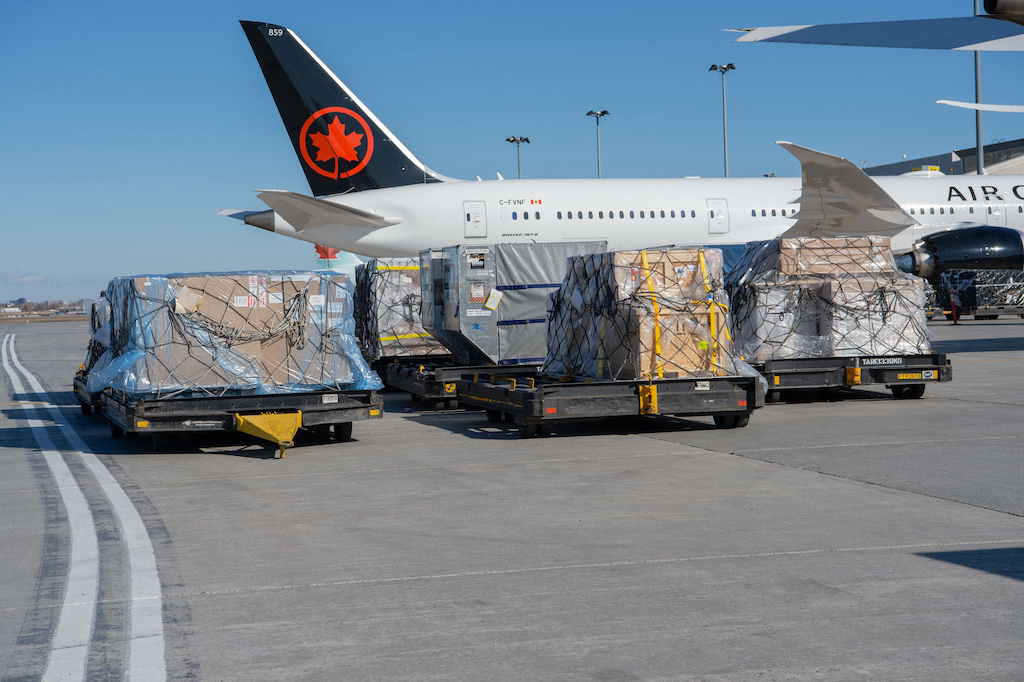Shipping Bottlenecks Are Giving Air Canada a Big Cargo Boost

Photo Credit: Air Canada Cargo
Air Canada, particularly hurt by stringent travel restrictions in its home country, continues to get a lift from its cargo business, aided by frustrations about bottlenecks and shipping delays for cargo on ships. Air Canada's story is yet another sign that that cargo will continue to be an increasingly strong revenue source for airlines even after the pandemic recedes.
The carrier is converting part of its retired Boeing 767-300ER fleet to freighters — Air Canada's first dedicated freighters — and expects to take delivery of two this year with more to follow next year. Initially, the aircraft will fly routes between Toronto and Miami, Quito, Lima, Mexico City, and Guadalajara. And in 2022, as more freighters join the fleet, Air Canada expects to add Halifax, St. John's, Madrid, and Frankfurt to its cargo network.
During the pandemic, Air Canada flew more than 9,000 cargo-only flights on 11 Boeing 777 and Airbus A330 aircraft that were temporarily converted into freighters by removing seats in the passenger cabin, as well as on unconverted widebody passenger aircraft on cargo-only flights. Canada's strict quarantines and entry requirements essentially stalled Air Canada's international and U.S. transborder passenger network during the pandemic and forced Porter Airlines and Transat to suspend all flights until later this summer.
In turning to air cargo, Air Canada was not alone. American Airlines and United Airlines, for example, each flew about 10,000 cargo-only flights on "preighters" (passenger jets used as freighters) during the pandemic. Air Canada said it will convert its preighters back to passenger service when demand warrants.
Initially, airlines used these aircraft to airlift much-needed personal protective equipment and other medical necessities early in the pandemic. But when the urgency for those goods receded, airlines found growing demand for cargo as locked-down populations shifted spending to e-commerce. Some airlines, like Korean Air, have been consistently profitable during the pandemic on the strength of e-commerce.
The shift toward cargo may be structural, IATA Chief Economist Brian Pearce has said. Although cargo was always an important revenue stream for the airline industry, it was secondary. Now, airlines are paying more attention. "Airlines are looking seriously at cargo in a way they haven’t before, and this will have lasting effects,” Pearce said.
With the collapse of international passenger traffic, belly-hold cargo space disappeared, forcing airlines to operate preighters or turn to dedicated freighters. Although this has driven cargo yields up, profit margins will fall as airlines add more international flights.
Yet, one factor that will keep air cargo yields high even after international passenger flights resume is the bottleneck in maritime cargo. Berth space at ports in North America, Asia, and Europe is at a premium, with container ships often waiting weeks to offload and take on new cargo. Adding to these woes, a Covid-19 outbreak at a port in China has resulted in a three-week delay in shipping from that country. And this is after the Suez Canal blockage earlier this year that held up as much as $10 billion in goods for each of the six days of the blockage.
All of this comes as the global economy starts to shake off its pandemic torpor. Companies are rushing to restock inventories, just as consumers are beginning to spend in earnest again. Maritime freight could take as much as a year to recover and return to equilibrium. Air freight will remain crucial to keep supply chains humming again, Pearce said.
Air Canada is one of a few airlines adding freighters. In North America, Sun Country relied on its new cargo fleet for Amazon during the pandemic. Mesa Air Group last year added its first freighters for DHL and is expanding that fleet. In Asia, AirAsia last week said it is adding one Boeing 737 and two Airbus A320 passenger conversions to its fleet for package deliveries in Southeast Asia.
Note: This story has been updated with comment from Air Canada and more details on Air Canada's freighter fleet.
